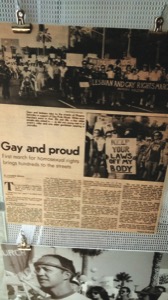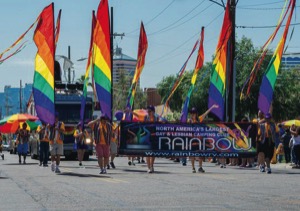
A simple proclamation, “We Are Here”, is printed on a souvenir button from Phoenix, Arizona’s first march for gay and lesbian rights. The cherished button and official program have been collecting dust in a memorabilia filled cardboard box since June 27, 1981. I’ve kept them all these years because the event was transformative and life-changing.
THEN: I had girlfriends in college, going through the motions, doing what was expected. That all changed one day when a handsome broad shouldered guy walked into the classroom and fireworks went off. I was stunned and bewildered by this sudden unknown, aka “long repressed”, desire. We were pursuing the same undergraduate degree, became friends and moved in together eventually as we fulfilled our scholastic obligations. Struggling with the awareness of an undeniable sexual attraction to my roommate while living and working in a small backwater town, was a difficult task filled with deeply disturbing days of dark depression. I sought professional help and my therapist asked if I had any “gay friends?” A sudden moment of cognition struck like a bolt of lightning.
Yes, you could say I was naive.
I was soon spending weekends running around Phoenix with college pals, and never again saw my therapist. My friends introduced me to gay dance clubs which was an exhilarating experience, then invited me to participate in the upcoming gay rights march. Which was a terrifying proposition.
Not only could I be fired for being gay, but I was also concerned for my safety – not an unfounded worry given Arizona’s history of discrimination and intolerance. Security was on the minds of the event organizers, too, as indicated by the “10-15 Phoenix City Officers and 40-50 civilian marshals” who would accompany the contingent.

Remember, this was a political march – an act of civil disobedience. A demonstration, not a celebration. This was a time before Ellen, Will & Grace and Glee. In 1981, sodomy laws criminalizing consensual gay sex were still on the books in Arizona; the Moral Majority, Jerry Falwell’s “pro-family” Christian right organization, launched its national anti-gay crusade; gay bars boycotted Coors Beer due to the corporation’s discriminatory stance; and reports of a “gay cancer” which would become known as AIDS were first published by the Centers for Disease Control.
With trepidation, my friends and I joined about 700 other participants in the two-mile march down Washington Street from Patriots Square to the rally site at the state Capitol building. Banners flew, hand-painted posters waved, and the air was filled with chants; “Hey hey ho ho Moral Majority’s got to go”, and “What do we want? Equal rights. When do we want them? Now!” Our noisy progress was largely unobserved. Most of the pedestrians we passed wore expressions of curiosity. Several seemed surprised. A handful frowned and gave us a thumbs down.
My fears washed away in a flood of joy as the boisterous company entered the rally site. The gay anthem, Sister Sledge’s “We Are Family,” was blasting from the loudspeakers, and I felt safe with my newly discovered “tribe”. From that moment on, I have lived my life as an out and proud gay man dedicated to obtaining full equality for LGBT Americans.
NOW: My editor thought it would be a good idea to return to Pride and see how things have changed over the ensuing years. Politically, there’s been a seismic shift since the heady days of 1981:
• Arizona sodomy laws were repealed in 2001. The state’s same-sex marriage ban was ruled unconstitutional by U.S. district court October 17, 2014.

• The Moral Majority disbanded in 1989 due to financial difficulties. Falwell died in 2007. The Christian right continues to attack LGBT civil rights.
• In response to the boycott, Coors was one of the first major corporations to offer same-sex domestic partner benefits in 1995, but the Coors family continues to fund anti-gay right wing organizations.
I called my friend, the notorious Miss Scarlet, and told her I was coming to Phoenix on business. Turns out she participated in the first march, too. She said she would be driving her jeep in the parade and invited me to join along. “You can ride shotgun,” she said. Which, I thought, was the perfect way to return; a survivor of the AIDS scourge, a veteran of the Culture War’s early battles. Triumphant.
Miss Scarlet and I would be joined by two friends, a young 20-year-old man and his mother. Ironically, this was his first time riding in a Pride parade. He told me he always knew he was gay. I was struck by how he grew up in an age of acceptance and freedom which, given my history of small town naiveté, would have been unimaginable. But I’m glad the world has changed enough for him to mature as a proud gay man without reproach.
Parade day dawned with a thin gauze of overcast sky which I hoped would linger, but didn’t. We arrived early at the parade staging area. What started as a political protest has grown to a jamboree. Where 700 people once marched, 3,000 participants now parade proudly down the street with brass bands, floats, politicians and youth groups. Where a small rally once provided a podium for gay activists, today a festival site draws 35,000 celebrants and features live entertainment, a dance pavilion, food, drink and numerous merchant booths.

10,000 attendees cheered and waved from the sidewalks as our brightly colored four-wheel drive vehicles snaked up Third Street. The Cactus4Wheelers, a fun group of off-road enthusiasts, were bedecked in the colors of the rainbow, each vehicle representing a separate hue. Our jeep was orange; the flag was orange, the balloons were orange, my glittery over-sized sunglasses were orange. An unblinking sun blazed overhead. Temperatures hovered in the upper 80s. A few hours later at the end of the parade, we gathered for lunch on Hula’s shady patio where I guzzled several glasses of ice water.
During conversation I learned one of the off-road enthusiasts, an employee of the public school system, was “a tad nervous” about participating in the parade, because she could be fired for being lesbian. “What sort of anti-discrimination policies does the school district have?” I asked, incredulous. “Everything but the gays,” she replied.
I guess some things haven’t changed. Even though she has the right to marry her partner, gays and lesbians in Arizona still face discrimination in employment and housing. Their civil rights are constantly being threatened. Arizona’s anti-gay “Religious Freedom Restoration Act”, SB 1062, was passed by the GOP controlled legislature but, under threat of an economic backlash, was vetoed by Gov. Jan Brewer in February, 2014.
A vivid reminder of how even though we’ve made tremendous strides in achieving equality, there is work yet to be done. I’m confident however, for the sake of our 20-year-old ride-along and others like him, for the sake of the school teacher and others like her, the final battles of the Culture War will not only be fought, but ultimately won.
Because we are here, and we’re not going away.











